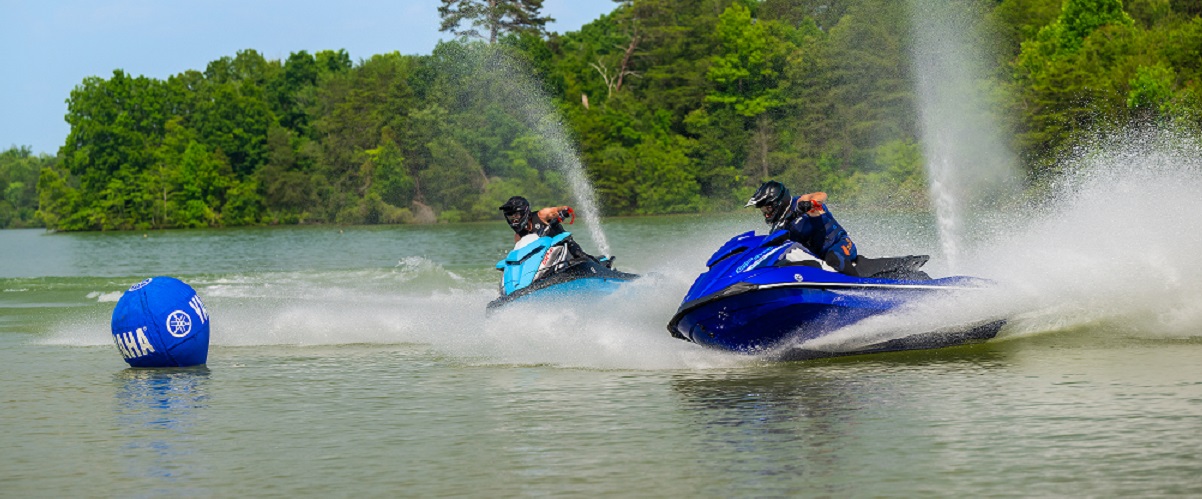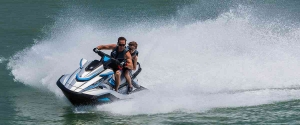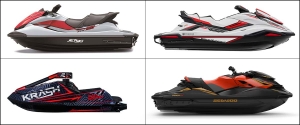
2024 Yamaha GP HO and SVHO Review: Top Speed, HP, Prices, Specs
According to the manufacturer, the GP is the #1 choice for championship riders which makes it so attractive for many other performance-minded buyers. That’s why this ski has tons of fans and is one of the best-selling performance PWCs each year!
What’s more, the GP can be opted for with two engine configurations, the 1.9L HO naturally-aspirated 200hp and the 1.8L SVHO supercharged 250hp power mill.
Referring to their power sources, the model names of these WaveRunners are GP HO and GP SVHO, respectively.
If you’d like to learn about and compare them head-to-head, you’ve come to the right place.
We, at JetDrift, have compiled the most recently available information, specs as well as pictures, and test videos into this 2024 Yamaha GP review!
2024 Yamaha GP Review
What’s New in 2024?
If you are familiar with the GP family, you probably want to know what’s new in this line for 2024.
Without further ado, the key changes in the latest GP series are as follows:GP HO (naturally-aspirated) 2024 changes:
- Rebranded model name (GP1800R HO to GP HO)
- New engine: New 200hp, 1.9L HO engine
- Redesigned impeller and intake grate
- Launch control and auto trim now come standard on the HO
- Enlarged, 7” Connext touchscreen
- New color schemes: Black With Cyan or Black With Torch Red
- Higher price tag: $14,499 (up: $300)
- Rebranded model name (GP1800R SVHO to GP SVHO)
- New color schemes: Black or Racing Blue
- Higher price tag: $16,799 (up: $300)
GP HO vs. SVHO Comparison
If we’re checking Yamaha’s 2024 performance and race-class WaveRunners, we can find three different models in this line.
The first is the legendary Yamaha Superjet (which is a stand-up model), and beyond this, there are still two sit-down WaveRunners in this family, namely the GP HO and GP SVHO.
First things first, we need to clarify the names, as they can be confusing for even experienced PWC enthusiasts.
In the past, Yamaha released these models under different names, like VXR or GP1800R, but now these models arrive as GP HO and SVHO.
Renaming like this is not uncommon in the industry, and Yamaha probably wants to take advantage of the good reputation of the legendary GP series. Based on other information, Yamaha just wants to clarify that these models belong to the same family, as the different names caused some confusion on the market.
The GP HO and GP SVHO borrow their hull from the VX line, but they are powered by high-performance engines.
You can find the all-new naturally-aspirated 1.9L HO engine in the GP HO, while the GP SVHO comes with a supercharged 250hp engine.
Let’s drill into the details and talk about the features of these skis in detail!
Hull and Dimensions
As mentioned previously, both the GP HO and the SVHO arrive on the same platform.
This high-end racing WaveRunner hull and deck are made of lightweight NanoXcel2 material, which is the key to the low net weight of the GP models.
Compared to its predecessor, the NanoXcel2 is no less than 18% lighter while its quality has not diminished. So it means you can expect the same rigidity and strength just as with any previous NanoXcel hulls, and it’s just as easily repairable. Beyond the much better power-to-weight ratios, the new hull ensures a more responsive riding experience and easier handling.
While the two models are basically the same, you can notice slight differences in their weights, as the GP HO weighs 710 pounds dry, while the dry weight of the SVHO is 754 pounds.
This small difference comes from the different engine sizes and weights.
Speaking of the dimensions, the GPs are not the biggest WaveRunners in Yamaha’s fleet since they are 131.9 inches long, 48.8 inches wide, and 47.2 inches high. Compared to the flagship FX series, the GPs are 9 inches shorter and 1.2 inches slimmer.
Because of the shorter hull, you can expect a slightly smaller swim platform, but it’s not the priority of any race PWC. Fortunately, the manufacturer didn’t forget to install a tow hook into the rear side of the deck, so if you’re considering wakeboarding or pulling a tube, you can attach your tow rope easily to it.
But let’s face it; this is not the best PWC for wakeboarding, as you can find specially designed crafts for this purpose, like the Sea-Doo Wake series. The GP also features professional and convenient, two-tone deck mats in the footwells and on the swim platform.
Engines
“How much HP does the Yamaha GP have?”This is one of the most common questions among PWC enthusiasts and for good reason, as Yamaha surprisingly doesn’t release the official performance specifications for their models. But the sticker in the hull clearly states all the specifications. So, based on these specs, the Yamaha GP HO has 200hp, while the GP SVHO offers 250hp.
Until 2023, both of these engines were based on the 1.8L High Output Yamaha marine engine, which was available in naturally-aspirated and supercharged configurations.
For 2024, the Japanese manufacturer introduced its upgraded 1.9L HO engine in the GP HO and the high-end VX models.
This engine is an 1898cc, 4-stroke, DOHC, inline-4 Yamaha marine engine delivering 200hp out of the box.
This unit was based on the 1.8L HO (180hp) but it has been improved in many ways including a larger displacement (+86cc), higher compression ratio, and revamped engine parts. The air intake and the exhaust system have also been tuned for better performance.
Unlike its smaller brothers, the engine of the GP SVHO has remained unchanged. This model still houses the supercharged configuration of the proven 1812cc, 4-stroke, DOHC, inline-4 High Output Yamaha Marine Engine rated at 250hp.
Below the waterline, we can notice some differences in the pumps as well, as the SVHO has a bigger 160mm high-pressure jet pump.
The HO comes standard with a slightly smaller 155mm pump, which was upgraded for 2024 with a redesigned impeller and intake grate.
These improvements were necessary to handle the extra 20hp of the new engine and they do a good job ensuring a faster acceleration and better hookup.
Both HO and SVHO engines are cooled with an industry-standard open-loop cooling system and have the largest displacements in the PWC industry (which makes them perfect for modifications).
Fuel Capacity and Storage
The fuel capacity of the GP series is also remarkable, as it has an 18.5-gallon fuel tank, and offers a total of 28.4 gallons of storage capacity. It is divided into three different storage compartments; a large bow storage with a smaller, 1.5-gallon removable, watertight storage compartment under the rear seat and the glovebox. This is the smallest storage with 0.9 gallons of capacity, and it also features two cup holders.
What’s more, you can extend the GP’s storage capacity with the optional accessory bag. According to the owner’s manual, the machine can carry 3 riders while the weight capacity is 530 pounds.
Features and Accessories
RiDE
Just like many other WaveRunners in Yamaha’s fleet, the GPs are also equipped with an electric trim system and a user-friendly brake and reverse system (called RiDE).
With this feature, you can switch from forward to reverse or even spin the WaveRunner easily and precisely with the dual handlebar controls. It results in safer rides and easier operating around docks and in tight places. If you want to learn more, you can discover Yamaha’s RiDE system and compare it to the Sea-Doo’s iBR here.Moreover, the GP arrives with dual remote transmitters, which can be used to activate Security mode and Low RPM mode, which are great safety features for beginners or inexperienced riders. Alternatively, this mode helps you to achieve the greatest fuel economy.
The Security mode can be activated with the other button, which can prevent unauthorized startups.
Seat
The ergonomic, textured, racing-style saddle is designed for maximum comfort and grip, while the well-designed bolster secures you in the right position. Removing the rear part of the 2-piece saddle allows you to access the watertight storage (1.5 gallons).
It’s also spacious enough to offer comfortable rides for 3 adults, unlike some smaller PWC models, where the rear seat is mainly comfortable for children.
LCD Screen
The LCD screen is quite simple, but it does the job well as it provides the most important information you need on the water. It features a huge speedometer, tachometer, boost and fuel gauge, check engine light, and trim settings.
Reboarding Step and Mirrors
Just like many other high-end Yamaha PWCs, the GPs feature dual mirrors and a wide, retractable reboarding step which is a great addition to help you get back on the WaveRunner after watersport or a swim.
Bilge Pump
You can find an automatic bilge pump in the hull, which is a great help if there’s some water in the bilge, or even if the WaveRunner starts to sink for any reason.
2024 Yamaha GP Top Speed and Fuel Consumption
Top Speed and Acceleration
Beyond the factory performance specs, every performance-minded buyer asks: How fast does a Yamaha GP go?Being the fastest WaveRunner on the market, the Yamaha GP SVHO’s top speed is 67-69 mph, thanks to an electronic speed limiter, which is installed in every US model by default. Overriding the limiter, you can expect around 78-80 mph!
Although it’s powered by a (200 HP) naturally-aspirated engine, you can expect the stock Yamaha GP HO’s top speed to be in the same range, around 63-65 mph. When it comes to acceleration, both models can reach from 0 to 30 mph in under two seconds, however, the SVHO is noticeably more aggressive.
Yamaha GP Fuel Consumption
Speaking of the GP SVHO’s fuel consumption, you can find its best cruise speed at 4,000 RPM which means 25-26 mph cruising speed and 7.5-8 mpg. At this speed, you can expect around 5 hours of riding time.
But please note that the WaveRunner’s fuel consumption depends on several factors, like weather conditions, curb weight, and many others. What’s more, when you’re planning your tours, it’s always wise to keep in mind the 1/3-1/3 fuel management rule for safety reasons.
If you want to go faster, riding with 37-38 mph at 5,000 rpm will lead to less fuel efficiency, resulting in 5.8-6 mpg, and the endurance also drops dramatically, as it’s just 2.5-2.6 hours.
The WaveRunners are less fuel-efficient at top speed, just like any other vehicle powered with an internal consumption engine. What’s more, supercharged engines are known for burning tons of gas, so that’s why you can expect to burn around 20+ gallons every hour on the supercharged GP SVHO at WOT.
Speaking of the Yamaha GP HO’s gas consumption, it’s safe to say that this model is much better on gas at higher speed thanks especially to the lack of the supercharger and the slightly lower curb weight.
If you ride it at full speed, it burns around 13-14 gallons of gas every hour, and that translates to 5 miles per gallon. The best cruise speed of the GP HO is 20 mph (at 4,000 rpm) which means much better consumption figures: 2.6 gph, and 8.1 mpg.
Performance and Riding Experience
There are no doubts that the GP is an out-of-the-box racing WaveRunner, designed to win championships. Currently, this is the most aggressive, fastest WaveRunner on the market, which has become a legend already in the year of its appearance.Even if it has the same size and many similarities to the VX series, the riding experience is completely different. The GP also surprises you with a much more lively and agile behavior than the bulky cruisers. You can expect precise and fast turning thanks to the unique design of the hull, as well as the custom sponsons.
The accelerations are also amazing and smooth, as the design of the new ride plate helps to reduce the bow-rise, while the top-loader intake grate delivers more water to the impeller. In this way, you can expect maximum thrust while turning or even on choppy water.
Considering the GP’s performance, it’s definitely not for beginners.
Even if you’re an experienced rider, this doesn’t mean that you should test its limits on the first day, as you can find yourself quickly in the water or in an even worse situation. Although the GP’s size and capacity make it perfect even for families, if you’re looking for a “family WaveRunner” you should instead take a look at the FX series.
Price Tags and Competitors
For those who stick to this amazing PWC, their next question is probably this: How much is a Yamaha GP?If we take a look at the 2024 Yamaha GP price tags, we are surprised to find that these are among the most affordable performance PWCs in this current year. It means the GP HO is available for $14,499, while the GP SVHO’s price is higher due to its supercharged engine; it costs $16,799.Are you wondering what are the competitor models from the other manufacturers?
The flagship racing-class Sea-Doo, the RXP-X 325 is considered a worthy opponent. This PWC offers significantly more power, but a higher net weight (776 pounds). You can purchase this high-end Sea-Doo for $19,199 in 2024.
Kawasaki’s racing-class Jet Ski, the Ultra 310X, also deserves a look. Being the most powerful Jet Ski on the market, the Ultra 310X comes with 310 HP and 1,032 pounds of curb weight (net weight: 892 pounds). The Kawasaki’s list price for the Ultra310X is $19,199, which makes it one of the most expensive performance PWCs on the market.
Conclusion
The 2024 GP SVHO is a racing-ready WaveRunner that you can buy off the shelf. Whether you want to race it or just create great adrenalin rushes on the weekends, the GP SVHO is one of the best choices for you.This is the fastest WaveRunner with the most aggressive attitude released by Yamaha ever. It arrives with the lightweight NanoXcel2 hull and deck, which ensures an outstanding power-to-weight ratio.
Beyond the 1,812cc supercharged (250 HP) engine, the GP SVHO features several race-inspired parts like the top-loader intake grate, the redesigned ride plate, and the unique sponsons, which offer great handling and amazing performance.
According to the manufacturer, this is the most dominant race personal watercraft since it was released, winning several World Championships in several classes. If you’re happy with less power but still want to ride GP, the 2024 GP HO is for you. With the naturally aspirated, 1.9L HO (200hp) engine this model needs less maintenance and is more fuel-efficient, especially at higher speeds.
Although these WaveRunners are amazing, they’re not for everybody (especially the SVHO). If you’re a beginner, you should take a look at the FX or the VX family, as these models are known for more comfort and ease of handling.
Last but not least, WaveRunners’ reliability is legendary, so if you want to spend more time on the water than in the repair shops, you can’t go wrong with any Yamaha watercraft.
Moreover, it’s good to know that all WaveRunners are manufactured in the United States!
This was our short Yamaha GP review, we hope you like it!

![WaveRunner Horsepower Chart [All 2024 Models] Yamaha WaveRunner Horsepower Chart](https://www.jetdrift.com/wp-content/uploads/2019/12/yamaha-waverunner-horsepower-chart-300x125.jpg)
